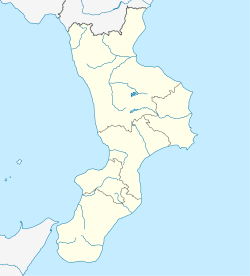Our website is made possible by displaying online advertisements to our visitors.
Please consider supporting us by disabling your ad blocker.
Martone
This article has multiple issues. Please help improve it or discuss these issues on the talk page. (Learn how and when to remove these messages)
|
Martone | |
|---|---|
| Comune di Martone | |
| Coordinates: 38°21′N 16°17′E / 38.350°N 16.283°E | |
| Country | Italy |
| Region | Calabria |
| Metropolitan city | Reggio Calabria (RC) |
| Frazioni | Poligori |
| Area | |
• Total | 8 km2 (3 sq mi) |
| Population (2001)[2] | |
• Total | 597 |
| • Density | 75/km2 (190/sq mi) |
| Demonym | Martonesi (Martunisi) |
| Time zone | UTC+1 (CET) |
| • Summer (DST) | UTC+2 (CEST) |
| Postal code | 89040 |
| Dialing code | 0964 |
| Patron saint | Saint George (Santu San Giorgi) |
| Saint day | 23 April |
| Website | Official website |
Martone (in Calabrian also referred as Màrtuni) is a comune in the province of Reggio Calabria, Calabria, in the south of Italy. It originated in the 7th and 8th centuries. The comune was founded by Greek monks from the Byzantine Orient who travelled from regions of the Aegean-Levantine to escape Syrian persecution.
Martone, like all the Locride area, was part of Greek monasticism; it is known that "the monks were living solitarily in grottos or in convents bound by the oath of chastity in the communal bond of prayer and work. The emaciated Christ which the Byzantine iconography had perpetuated for centuries, the suave darkish face of the Mother of God in the icons and frescos and the vast series of Saints, did make their solitude quite serene, did alleviate the heavy toils, and were reawakening the sign of the Orient in the peace of the ascetic dwellings and in the squalor of the grottos".[3]
Also in the Grotto Territory, which included the municipalities of Mammola, Martone and St. Giovanni di Gerace, there were "small monastic churches, which though not competing in historic artefacts with those of Stilo and of the Paterion di Rossano, nevertheless they still preserve traces of Byzantine art".[4]
"These monasteries were not only intended to preserve the relicts of antiquity, as in Vico's expressions but also a school of agriculture and trades, reforesting, land-reclaiming, cultivating, ploughing, sowing, intensifying the cultivation of olive trees, of vines and chestnuts, building aqueducts and mills, opening the way to the first artisan activities and representing the heralds of the protection of the rural population, in a calamitous and decentralized age which was the Byzantine".[5]
- ^ "Superficie di Comuni Province e Regioni italiane al 9 ottobre 2011". Italian National Institute of Statistics. Retrieved 16 March 2019.
- ^ All demographics and other statistics from the Italian statistical institute (Istat)
- ^ Musolino, Giovanni (1966). Calabria bizantina [Byzantine Calabria] (in Italian). Venice: F. Ongania. p. 9. OCLC 15319077.
- ^ Russo, F. (1979). Monasticism in the Locride (in Italian). Rome. p. 34.
{{cite book}}: CS1 maint: location missing publisher (link) - ^ Barillaro, Emilio (1969). Il mio bel San Giovanni (in Italian). S.Giovanni di Gerace: Ed. Nossis. p. 23. OCLC 632992966.
Previous Page Next Page






